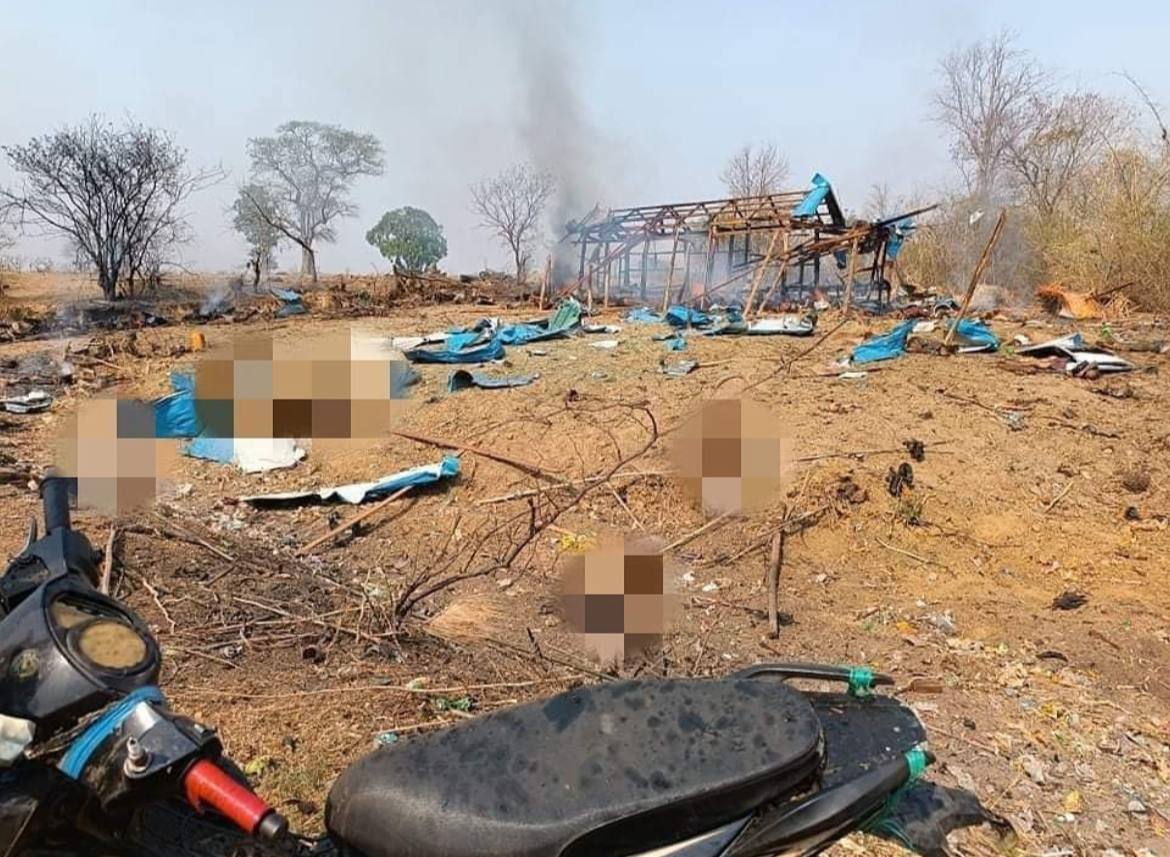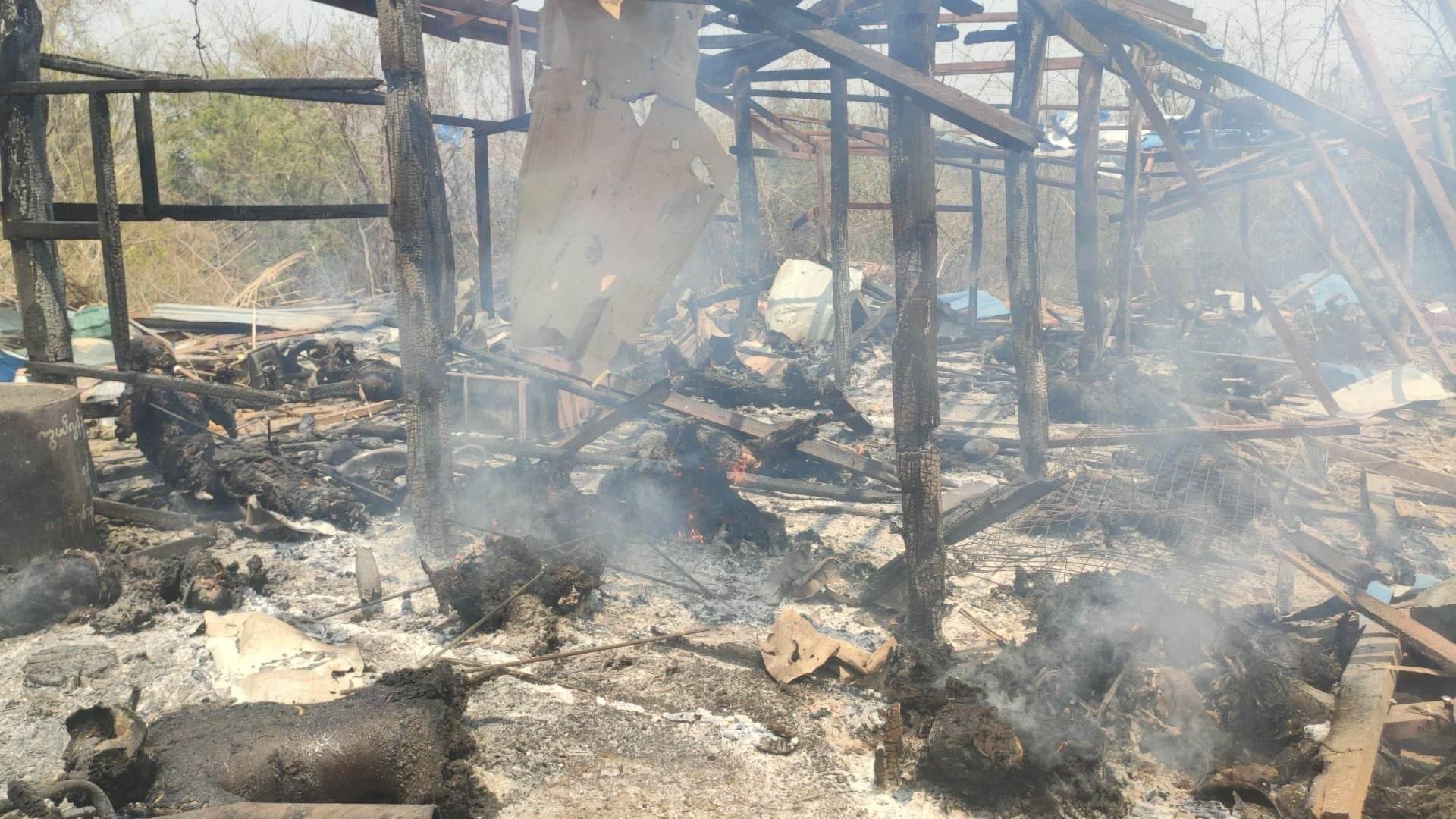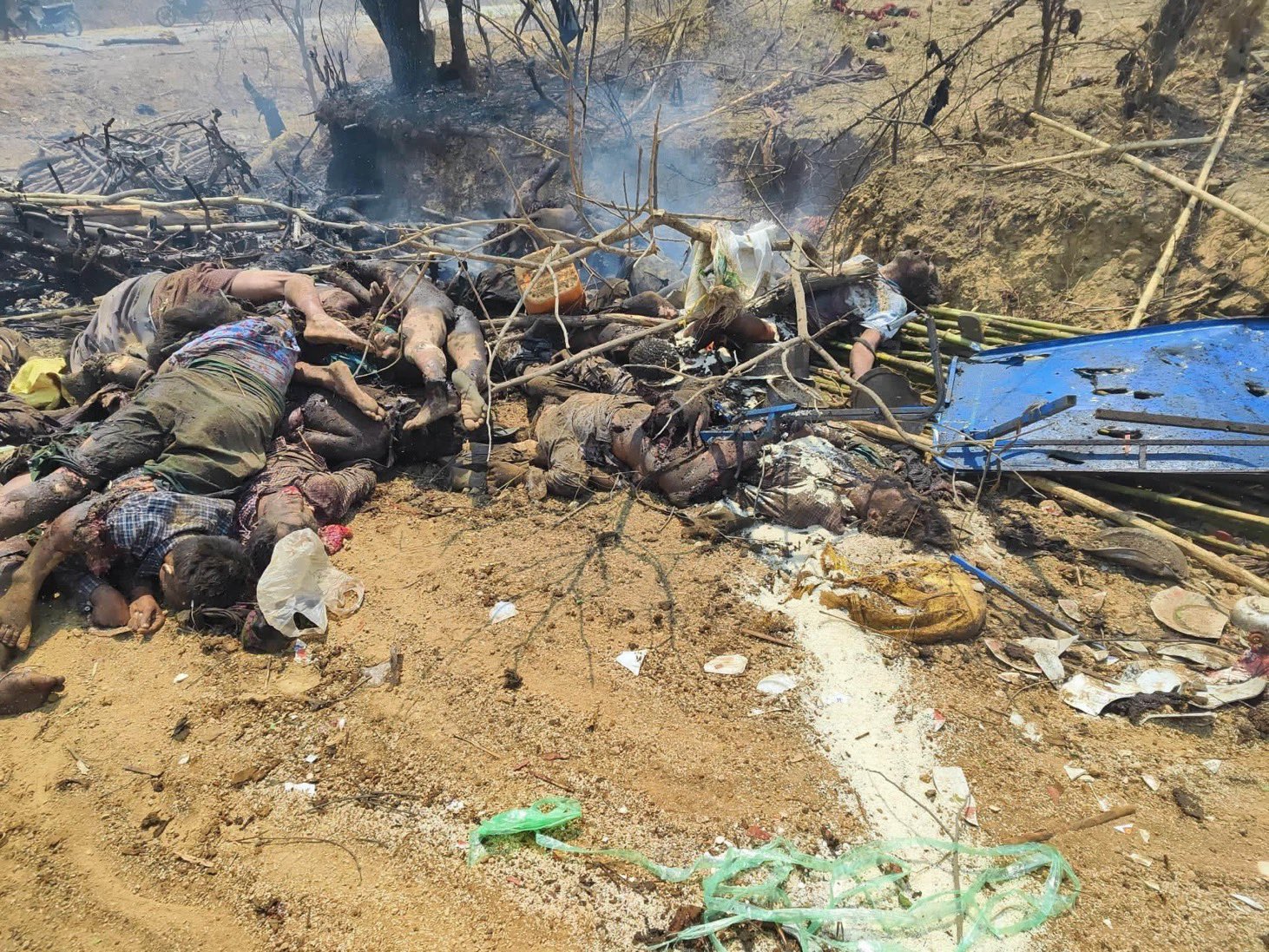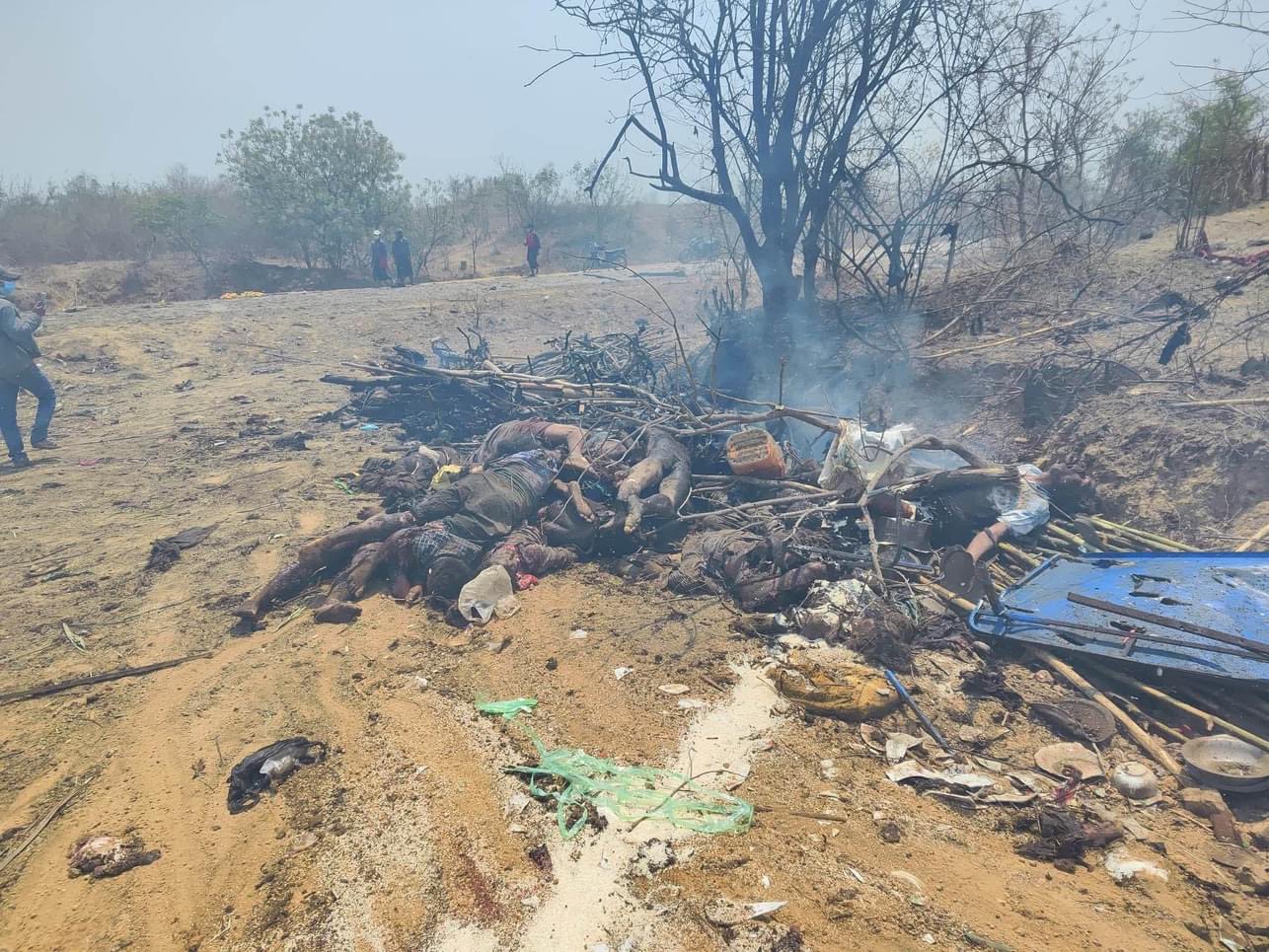Latest Thread
You are using an out of date browser. It may not display this or other websites correctly.
You should upgrade or use an alternative browser.
You should upgrade or use an alternative browser.
Live Conflict Myanmar Civil War
- Thread starter Mis_TR_Like
- Start date
Karenni resistance forces have captured a junta camp on the eastern side of the Salween river in Kayah state.
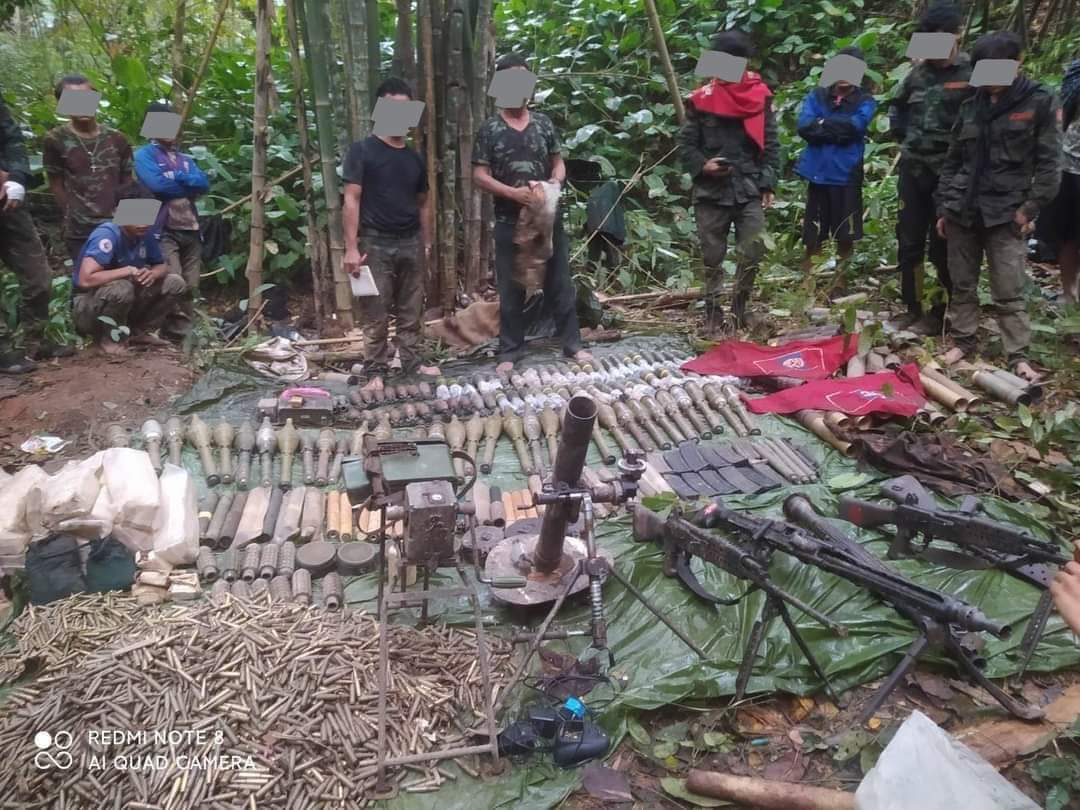
Yangon Urban Guerilla Force announced the firing of 8 107mm missiles at Hmawbi airbase, at hangars housing Mig 29, Y-12, and Mi 17 aircraft. Damage unknown.

Burmese sources are reporting that Karenni resistance scored a major victory against junta forces on the border between Shan and Kayah state. A large number of soldiers were killed and many weapons captured.
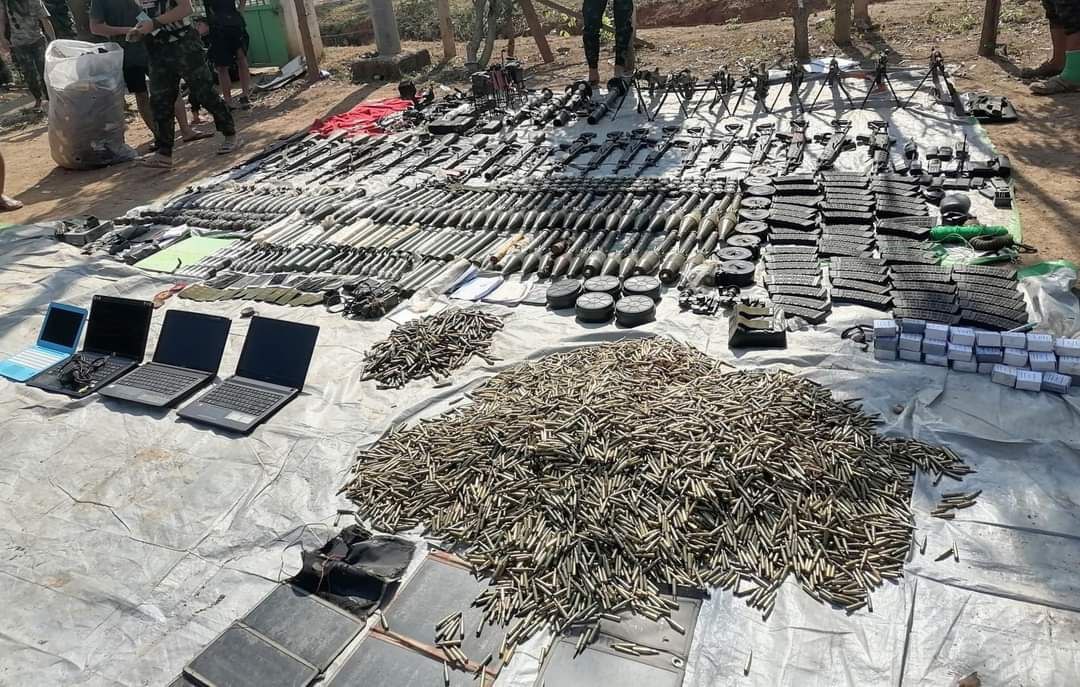
last night resistance forces raided the Bukan police station in the Tamu Township of northern Sagaing, burning down the building and seizing several weapons.


last night resistance forces raided the Bukan police station in the Tamu Township of northern Sagaing, burning down the building and seizing several weapons.

Resistance groups in Myanmar have developed a method to drop two bomblets from a drone, in order to attack isolated police and junta outposts in rural Sagaing townships.
What a shit show.
I am not gonna say, people dying like this is a good thing.
But if it comes down to simple raw realpolitik, then I have to say, as long as they are cutting each other’s throat it is somewhat relaxing for BD's National Security.
I am not gonna say, people dying like this is a good thing.
But if it comes down to simple raw realpolitik, then I have to say, as long as they are cutting each other’s throat it is somewhat relaxing for BD's National Security.
F-6 enthusiast
Well-known member
DISTURBING IMAGES WARNING (FOOTAGE BLURRED BY ITV)
Not directly related to the civil war but hopefully this can help the population:
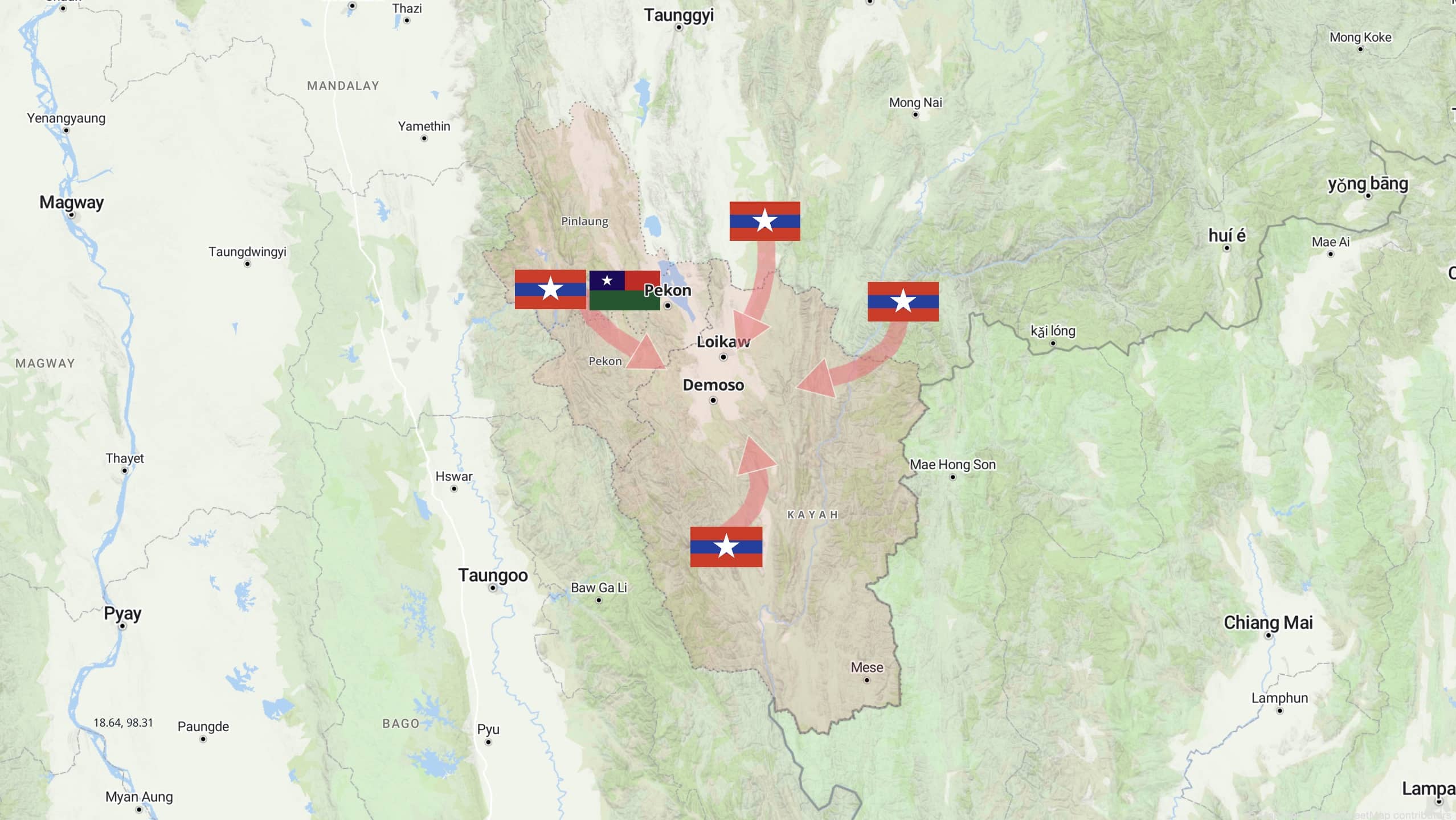
Battle for Kayah is key for Myanmar junta and its opponents - IISS Myanmar Conflict Map
The battle for Kayah State, which is strategically located between resistance strongholds in the Dry Zone and the southeast, is now the longest episode of sustained, relatively high-intensity combat since Myanmar’s post-coup war began.
Record of a drone bombing of a military council camp in Karenni State
Yangon, July 9
A report of a drone bombing of a military council base camp in Karenni State has been published by Loikaw PDF.
The Karenni Revolutionary Coalition Forces, including Loikaw PDF and Falcon Wings, attacked a camp stationed by the terrorist military council, details of which were not released.
Yangon, July 9
A report of a drone bombing of a military council base camp in Karenni State has been published by Loikaw PDF.
The Karenni Revolutionary Coalition Forces, including Loikaw PDF and Falcon Wings, attacked a camp stationed by the terrorist military council, details of which were not released.
Myanmar army is shrinking fast, from an estimated 400.000 just 2 years ago to an estimated 70.000 in 2023. Yikes
Thursday, May 4, 2023 / BY: Ye Myo Hein
PUBLICATION TYPE: Analysis and Commentary
Share This
Print the Page
International actors seeking to end Myanmar’s civil war make an assumption that on its face appears reasonable: They need to focus on the coup regime for any resolution of the conflict, the thinking goes, because the military is simply too big to fail. But is it? The Sit-Tat, as the armed forces are known, is an opaque institution, shrouded in secrecy, with the question of its actual size a major mystery. As explained below, analysts who lack reliable evidence tend to make estimates of military manpower that are far too high. Deeper scrutiny, drawing on overlooked data as well as interviews with ex-soldiers and internal military documents, reveals the Myanmar military is in fact shrinking from a severe — and rapidly growing — shortage of personnel.
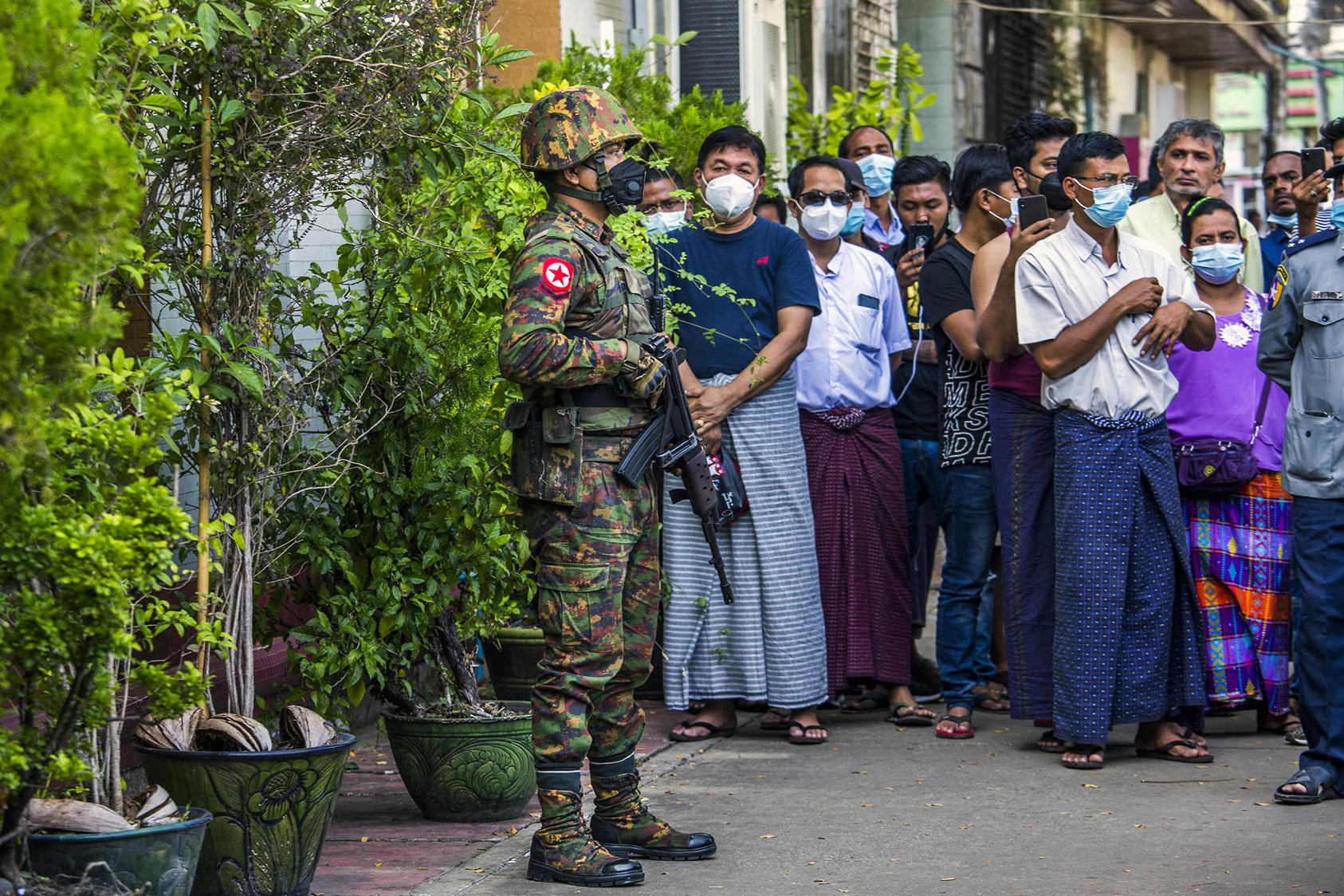 A soldier stands guard outside a Hindu temple in Yangon, Myanmar, Tuesday, Feb. 2, 2021. USIP’s analysis reveals that Myanmar’s army is weaker and smaller than many believe. (The New York Times)
A soldier stands guard outside a Hindu temple in Yangon, Myanmar, Tuesday, Feb. 2, 2021. USIP’s analysis reveals that Myanmar’s army is weaker and smaller than many believe. (The New York Times)
While analysts tend to agree that the Sit-Tat has lost considerable strength since the coup, the lack of reliable data on current troop levels has prompted use of inflated pre-coup numbers as a benchmark. By pairing available information about the military’s organizational structure with conventional estimates of unit size, these analysts arrive at dubious assessments. Before the coup, the military headcount was widely thought to total 300,000-400,000. But these estimates, too, rest primarily on undependable data. The true number is almost certainly no more than half the historical benchmark.
The alternative estimate presented here is based on extensive interviews with military deserters and defectors, analysis of internal military directives and meeting notes, historical records of troop movements and sizes, and casualty counts from primary conflict data and military hospital records. I conclude that the military currently has about 150,000 personnel. Roughly 70,000 are combat soldiers. At least 21,000 service members have been lost through casualties, desertion and defection since the coup. At this troop level, the Sit-Tat is barely able to sustain itself as a fighting force, much less a government.
It is no longer reasonable to assume that an enfeebled military will overcome the resistance movement and consolidate its praetorian rule. Therefore, the international community should stop engaging with the junta as if it is bound to win and the only relevant player in achieving stability. That approach only bolsters the generals’ delusion that they will defeat the opposition and delays the time until the junta comes to the table.
Consequently, the widespread, enduring conflict sparked by the 2021 military coup has shocked many of these same analysts who predicted quick defeat for the out-gunned resistance. That has given rise to a new debate about the Sit-Taw’s actual size.
Since 1988, the Sit-Tat has significantly expanded its structure but not its proportional troop strength. The number of infantry battalions increased from 168 in 1988 to 504 in 2007, but the planned additional manpower never materialized, leaving battalions badly under-staffed. Maung Aung Myoe, the author of “Building the Tatmadaw,” wrote, “In 1988, the war establishment for a battalion was 777 personnel; it was revised in mid-1990 to make it 814 (in 2001, the formation was expanded to 857). But, according to some observers, the [average number of personnel] of the battalions has substantially declined: from 670 plus in 1988 to 350-plus in 1998 and 250-plus in 2008.”
The strength of many battalions, in fact, was under 200 troops in mid-2000. According to a 2005 document obtained by the author, Thein Sein, then adjutant general and later Myanmar’s president, said that the Sit-Tat had 284 battalions of fewer than 200 troops, and 220 battalions of between 200 and 300 troops.

Attached / Internal notes from a 2005 regional command meeting, obtained by USIP, recount what adjutant Thein Sein had said at a previous meeting of senior military leaders regarding the size of Myanmar’s military.
“There is a need to increase the number of new recruits in the army due to a low recruitment rate, and it is hard to recruit new soldiers,” he said. The meeting minute listed 8,760 losses (including battlefield dead, medically unfit, or discharged personnel) and 4,701 deserters for that year.
These figures show the Sit-Tat struggled with recruitment even during full-fledged military rule when the armed forces offered one of the few avenues to upward social mobility. Recruitment rates dropped even farther after the political opening of 2011 created fresh economic opportunities. The trendline led newly appointed Commander-in-Chief Min Aung Hlaing to initiate a program to modernize the Sit-Tat, which effectively meant beefing up air power and machinery to compensate for flagging troop strength. From 2010-2020, as Myanmar’s internal armed conflicts resumed on multiple fronts, the shortage of ground troops became a glaring problem for the military. For example, understaffing in Sit-Tat units fighting the Arakan Army in Rakhine State before the 2021 coup led military leaders to send even medically unfit soldiers to the field where they were easily captured by the AA.
According to one internal document, the 10 Light Infantry Divisions (LID) incorporate just 16,687 troops instead of the more than 20,000 that properly outfitted LID battalions would have. Of the 100 battalions that comprise the LIDs, 52 have 100-150 soldiers and 48 have 150-200 soldiers. This means that even these Light Infantry Divisions — the strongest of Myanmar’s combat forces — are seriously under-strength, according to the document. Defector interviews, as well as battlefield reports, have corroborated these figures. A leaked directive orders battalion commanders to only deploy units with at least 85 combat troops to the front and threatens punishment for commanders who fail to meet the quota.
A deserter confirmed this information to the author.
In 2001, war establishment for a battalion was expanded to 857 personnel — 31 officers and 826 rank-and-file personnel, he said. Due to a dearth of soldiers, the recommended size of a battalion was reduced to 200. At that level, a battalion was designed to deploy at least 120 personnel on the frontline, left 60 at the base, and about 20 were absent and/or serving outside the battalion. But few battalions even met the reduced 200-troop threshold, he said.
“Before I left the military in August 2021 there was no extensive fighting yet – and our battalion then could not deploy even 70 troops, including officers,” the deserter said.
According to another document, of the 21 frontline battalions deployed in Karen State, 14 have fewer than 85 troops including officers, and only seven have more than 85 troops. A military deserter in Karen State said his battalion left fewer than 40 soldiers at base and most were deployed to guard banks, administrative offices and the towns where the base is located. As a result, the military was forced to train the wives and family members of soldiers, even mid-ranking officers, to defend its bases.
Casualties have also taken a toll. The NUG estimates that roughly 20,000 junta combat troops have been killed since the coup. Some analysts estimate that “battlefield losses, killed and badly wounded, would be somewhere between 10,000 and 15,000 in two years.” Dominic Faulder of Nikkei Asia wrote in a recent report that the Sit-Tat has been losing up to 15 combat troops on average each day. That would equate to almost 5,500 in a year or 11,000 since the coup, he said.
The author’s daily analysis of military deaths from battlefield reports, internal military documents and military hospital reports, which are substantiated by ground troop data and interviews with defectors, deserters, resistance forces and community members, suggest that the military has experienced about 13,000 battlefield deaths in the two years since the coup.
Annual recruitment typically matched desertions before the coup, but post-coup recruitment has slowed considerably. Chin, Rakhine and the ethnically Bamar-majority areas in central Burma, previously the primary sources for Sit-Tat recruits, are now at the center of the resistance. Junta atrocities in these areas have deepened the recruitment crisis by severing the links between the Bamar majority and the military they once endearingly called the Tatmadaw (Royal Armed Forces).
To counter the pressures on manpower, the military has expanded incentives for recruits since the coup. According to one deserter, the Sit-Tat raised its recruitment bonus to 2.5 million kyats, on average, from 500,000 kyats. Moreover, the military has been forced to accept “criminals, those with heavy debts and drug addicts.” Even the Defense Services Academy, a major source of future officers, has experienced a significant decline in applications after the coup. If nothing else, this demonstrates the military’s desperation and is another data point for an enfeebled Sit-Tat.
“I primarily worked on falsifying data of deserters in my battalion prior to my defection to the resistance,” said a defector who served as an adjutant officer in the military. “The number of deserters was so high that the battalion commander asked us not to submit the full list because it would cause trouble for him, facing a charge or losing his chance of promotion. The frequency of data tampering was so high that even I was confused about the actual military strength of my battalion.”
The battalion commander kept the deserters on the active troop list and used their salaries as incentives for new recruits, the same deserter said. Senior officers are aware of the practice and complicit in it, he added.
“The false reporting is so widespread that even Commander in Chief Min Aung Hlaing and his deputy, Soe Win, do not know the actual number of Sit-Tat troops,” he said. As Andrew Selth, a foremost expert on the Myanmar military, wrote, the Sit-Tat’s actual size is one of its great “known unknowns.”
This uncertainty has led analysts to significantly overestimate the Sit-Tat’s strength.
Although precision remains elusive, the data points cited above offer a very different picture of the military’s size. Adding naval and air force personnel to the estimate of 70,000 military combat troops, as well as support and auxiliary corps, the entire war establishment of the Myanmar Sit-Tat is about 150,000 — significantly lower than the most reasonable pre-coup estimates of 200,000.
The military regards the 70,000 national police as an auxiliary force and deploys 12,000 of them as part of militarized units. The military also employs border guard forces and militias estimated at about 15,000 personnel.
Likewise, the military transferred personnel from support corps such as Electrical and Engineering, Signal, Military Training, Supply and Transport, and Ordinance This recently gained attention after an air force officer, who was offered a promotion if he fought on the front lines, was killed in a battle.
With ground forces severely limited, the use of air power — ineffective at holding territory — has increased. Between February 2021 and January 2023, the air force conducted at least 600 air attacks, most hitting civilian targets.
The junta has also shown its weakness by pleading for cease-fires with ethnic armed organizations such as the Arakan Army. Its objective is to redeploy forces from cease-fire areas like Rakhine to other conflict hotspots. The relative lull in fighting along the China-Myanmar border, perhaps mediated by China’s new special envoy, gave the junta breathing space to redeploy some 3,000 troops to more intense conflict areas.
Today, its mirage of strength is rapidly disintegrating in the face of a resilient, multi-front resistance and unprecedented public hatred.
It is high time for the international community, particularly those in the region of Myanmar, to take a hard look at assumptions about the Sit-Tat’s strength, recognize that the emperor has no clothes, and recalibrate their approach to this conflict.

 www.usip.org
www.usip.org
@Afif from the looks of it Myanmar has always had manpower issue, and those toys Tatmadaw brought is to compensate this lack of manpower and lack of recruitment.
Myanmar’s Military Is Smaller Than Commonly Thought — and Shrinking Fast
A lack of reliable data has led international actors to overrate the junta’s strength and its potential role in resolving the country’s conflict.Thursday, May 4, 2023 / BY: Ye Myo Hein
PUBLICATION TYPE: Analysis and Commentary
Share This
Print the Page
International actors seeking to end Myanmar’s civil war make an assumption that on its face appears reasonable: They need to focus on the coup regime for any resolution of the conflict, the thinking goes, because the military is simply too big to fail. But is it? The Sit-Tat, as the armed forces are known, is an opaque institution, shrouded in secrecy, with the question of its actual size a major mystery. As explained below, analysts who lack reliable evidence tend to make estimates of military manpower that are far too high. Deeper scrutiny, drawing on overlooked data as well as interviews with ex-soldiers and internal military documents, reveals the Myanmar military is in fact shrinking from a severe — and rapidly growing — shortage of personnel.

While analysts tend to agree that the Sit-Tat has lost considerable strength since the coup, the lack of reliable data on current troop levels has prompted use of inflated pre-coup numbers as a benchmark. By pairing available information about the military’s organizational structure with conventional estimates of unit size, these analysts arrive at dubious assessments. Before the coup, the military headcount was widely thought to total 300,000-400,000. But these estimates, too, rest primarily on undependable data. The true number is almost certainly no more than half the historical benchmark.
The alternative estimate presented here is based on extensive interviews with military deserters and defectors, analysis of internal military directives and meeting notes, historical records of troop movements and sizes, and casualty counts from primary conflict data and military hospital records. I conclude that the military currently has about 150,000 personnel. Roughly 70,000 are combat soldiers. At least 21,000 service members have been lost through casualties, desertion and defection since the coup. At this troop level, the Sit-Tat is barely able to sustain itself as a fighting force, much less a government.
It is no longer reasonable to assume that an enfeebled military will overcome the resistance movement and consolidate its praetorian rule. Therefore, the international community should stop engaging with the junta as if it is bound to win and the only relevant player in achieving stability. That approach only bolsters the generals’ delusion that they will defeat the opposition and delays the time until the junta comes to the table.
Myanmar’s Embattled Military Establishment
Pre-coup estimates of troop strength fell into a fairly narrow band. GlobalFirepower.com, a website that annually rates the strength of militaries around the world, estimated active personnel of the Sit-Tat at 400,000 as of 2021. The CIA’s the World Factbook said before the coup that “estimates vary widely, from approximately 300,000 to as many as 400,000 personnel.” Other estimates put the total strength of the Sit-Tat at between 300,000 and 350,000.Consequently, the widespread, enduring conflict sparked by the 2021 military coup has shocked many of these same analysts who predicted quick defeat for the out-gunned resistance. That has given rise to a new debate about the Sit-Taw’s actual size.
Since 1988, the Sit-Tat has significantly expanded its structure but not its proportional troop strength. The number of infantry battalions increased from 168 in 1988 to 504 in 2007, but the planned additional manpower never materialized, leaving battalions badly under-staffed. Maung Aung Myoe, the author of “Building the Tatmadaw,” wrote, “In 1988, the war establishment for a battalion was 777 personnel; it was revised in mid-1990 to make it 814 (in 2001, the formation was expanded to 857). But, according to some observers, the [average number of personnel] of the battalions has substantially declined: from 670 plus in 1988 to 350-plus in 1998 and 250-plus in 2008.”
The strength of many battalions, in fact, was under 200 troops in mid-2000. According to a 2005 document obtained by the author, Thein Sein, then adjutant general and later Myanmar’s president, said that the Sit-Tat had 284 battalions of fewer than 200 troops, and 220 battalions of between 200 and 300 troops.

Attached / Internal notes from a 2005 regional command meeting, obtained by USIP, recount what adjutant Thein Sein had said at a previous meeting of senior military leaders regarding the size of Myanmar’s military.
“There is a need to increase the number of new recruits in the army due to a low recruitment rate, and it is hard to recruit new soldiers,” he said. The meeting minute listed 8,760 losses (including battlefield dead, medically unfit, or discharged personnel) and 4,701 deserters for that year.
These figures show the Sit-Tat struggled with recruitment even during full-fledged military rule when the armed forces offered one of the few avenues to upward social mobility. Recruitment rates dropped even farther after the political opening of 2011 created fresh economic opportunities. The trendline led newly appointed Commander-in-Chief Min Aung Hlaing to initiate a program to modernize the Sit-Tat, which effectively meant beefing up air power and machinery to compensate for flagging troop strength. From 2010-2020, as Myanmar’s internal armed conflicts resumed on multiple fronts, the shortage of ground troops became a glaring problem for the military. For example, understaffing in Sit-Tat units fighting the Arakan Army in Rakhine State before the 2021 coup led military leaders to send even medically unfit soldiers to the field where they were easily captured by the AA.
Post-Coup Dynamics
Now, the post-coup rebellion is exacerbating the shortfall in combat forces. According to internal military documents possessed by the author, the army currently consists of 522 ground-troop battalions (217 infantry and 305 light infantry) almost all of which compromise fewer than 200 combat troops and many fewer than 150.According to one internal document, the 10 Light Infantry Divisions (LID) incorporate just 16,687 troops instead of the more than 20,000 that properly outfitted LID battalions would have. Of the 100 battalions that comprise the LIDs, 52 have 100-150 soldiers and 48 have 150-200 soldiers. This means that even these Light Infantry Divisions — the strongest of Myanmar’s combat forces — are seriously under-strength, according to the document. Defector interviews, as well as battlefield reports, have corroborated these figures. A leaked directive orders battalion commanders to only deploy units with at least 85 combat troops to the front and threatens punishment for commanders who fail to meet the quota.
A deserter confirmed this information to the author.
In 2001, war establishment for a battalion was expanded to 857 personnel — 31 officers and 826 rank-and-file personnel, he said. Due to a dearth of soldiers, the recommended size of a battalion was reduced to 200. At that level, a battalion was designed to deploy at least 120 personnel on the frontline, left 60 at the base, and about 20 were absent and/or serving outside the battalion. But few battalions even met the reduced 200-troop threshold, he said.
“Before I left the military in August 2021 there was no extensive fighting yet – and our battalion then could not deploy even 70 troops, including officers,” the deserter said.
According to another document, of the 21 frontline battalions deployed in Karen State, 14 have fewer than 85 troops including officers, and only seven have more than 85 troops. A military deserter in Karen State said his battalion left fewer than 40 soldiers at base and most were deployed to guard banks, administrative offices and the towns where the base is located. As a result, the military was forced to train the wives and family members of soldiers, even mid-ranking officers, to defend its bases.
Casualties, Defection and Desertion Up, Recruitment Down
Along with lagging recruitment, defections and desertions are weakening the military. Several sources estimate that 3,000 military personnel and 7,000 police have gone over to the resistance. An official of the National Unity Government (NUG) claims 3,236 military and 9,091 police personnel had defected as of February. Thousands more Sit-Tat soldiers have simply walked away. Even before the coup, desertion high rates were high — 4,701 deserters in 2005, for example. Although current data cannot support a high-confidence estimate, the current assessment is that at least 8,000 soldiers have defected or deserted since the coup.Casualties have also taken a toll. The NUG estimates that roughly 20,000 junta combat troops have been killed since the coup. Some analysts estimate that “battlefield losses, killed and badly wounded, would be somewhere between 10,000 and 15,000 in two years.” Dominic Faulder of Nikkei Asia wrote in a recent report that the Sit-Tat has been losing up to 15 combat troops on average each day. That would equate to almost 5,500 in a year or 11,000 since the coup, he said.
The author’s daily analysis of military deaths from battlefield reports, internal military documents and military hospital reports, which are substantiated by ground troop data and interviews with defectors, deserters, resistance forces and community members, suggest that the military has experienced about 13,000 battlefield deaths in the two years since the coup.
Annual recruitment typically matched desertions before the coup, but post-coup recruitment has slowed considerably. Chin, Rakhine and the ethnically Bamar-majority areas in central Burma, previously the primary sources for Sit-Tat recruits, are now at the center of the resistance. Junta atrocities in these areas have deepened the recruitment crisis by severing the links between the Bamar majority and the military they once endearingly called the Tatmadaw (Royal Armed Forces).
To counter the pressures on manpower, the military has expanded incentives for recruits since the coup. According to one deserter, the Sit-Tat raised its recruitment bonus to 2.5 million kyats, on average, from 500,000 kyats. Moreover, the military has been forced to accept “criminals, those with heavy debts and drug addicts.” Even the Defense Services Academy, a major source of future officers, has experienced a significant decline in applications after the coup. If nothing else, this demonstrates the military’s desperation and is another data point for an enfeebled Sit-Tat.
Falsification of Troop-Strength Data
Behind the lack of accurate and reliable information on Sit-Tat strength is its concealment and falsification of data at all levels.“I primarily worked on falsifying data of deserters in my battalion prior to my defection to the resistance,” said a defector who served as an adjutant officer in the military. “The number of deserters was so high that the battalion commander asked us not to submit the full list because it would cause trouble for him, facing a charge or losing his chance of promotion. The frequency of data tampering was so high that even I was confused about the actual military strength of my battalion.”
The battalion commander kept the deserters on the active troop list and used their salaries as incentives for new recruits, the same deserter said. Senior officers are aware of the practice and complicit in it, he added.
“The false reporting is so widespread that even Commander in Chief Min Aung Hlaing and his deputy, Soe Win, do not know the actual number of Sit-Tat troops,” he said. As Andrew Selth, a foremost expert on the Myanmar military, wrote, the Sit-Tat’s actual size is one of its great “known unknowns.”
This uncertainty has led analysts to significantly overestimate the Sit-Tat’s strength.
Although precision remains elusive, the data points cited above offer a very different picture of the military’s size. Adding naval and air force personnel to the estimate of 70,000 military combat troops, as well as support and auxiliary corps, the entire war establishment of the Myanmar Sit-Tat is about 150,000 — significantly lower than the most reasonable pre-coup estimates of 200,000.
The military regards the 70,000 national police as an auxiliary force and deploys 12,000 of them as part of militarized units. The military also employs border guard forces and militias estimated at about 15,000 personnel.
Further Evidence of Dwindling Strength
The vast expansion of support units’ deployment to the front provides further evidence of the Sit-Tat’s dwindling strength. The military has pulled troops from auxiliary and support corps, such as the air force, navy, and retired veterans. Even service personnel from Defense Industry Factories, who have no combat experience, have reportedly been mobilized into a battalion preparing for battle.Likewise, the military transferred personnel from support corps such as Electrical and Engineering, Signal, Military Training, Supply and Transport, and Ordinance This recently gained attention after an air force officer, who was offered a promotion if he fought on the front lines, was killed in a battle.
With ground forces severely limited, the use of air power — ineffective at holding territory — has increased. Between February 2021 and January 2023, the air force conducted at least 600 air attacks, most hitting civilian targets.
The junta has also shown its weakness by pleading for cease-fires with ethnic armed organizations such as the Arakan Army. Its objective is to redeploy forces from cease-fire areas like Rakhine to other conflict hotspots. The relative lull in fighting along the China-Myanmar border, perhaps mediated by China’s new special envoy, gave the junta breathing space to redeploy some 3,000 troops to more intense conflict areas.
Myanmar’s Generals Cannot Restore Stability
After decades of pouring the country’s limited resources into the Sit-Tat to ensure its grip on power, the military is now in its weakest and most vulnerable position. The generals have managed to conceal their weaknesses with brutality, but over the years a complex mix of corrupt officers, demoralized soldiers, hollowed out structures and eroding public support have taken a toll.Today, its mirage of strength is rapidly disintegrating in the face of a resilient, multi-front resistance and unprecedented public hatred.
It is high time for the international community, particularly those in the region of Myanmar, to take a hard look at assumptions about the Sit-Tat’s strength, recognize that the emperor has no clothes, and recalibrate their approach to this conflict.

Myanmar’s Military Is Smaller Than Commonly Thought — and Shrinking Fast
International actors seeking to end Myanmar’s civil war make an assumption that on its face appears reasonable: They need to focus on the coup regime for any resolution of the conflict, the thinking goes, because the military is simply too big to fail. But is it? The Sit-Tat, as the armed forces...
@Afif from the looks of it Myanmar has always had manpower issue, and those toys Tatmadaw brought is to compensate this lack of manpower and lack of recruitment.
Myanmar army is shrinking fast, from an estimated 400.000 just 2 years ago to an estimated 70.000 in 2023. Yikes
Myanmar’s Military Is Smaller Than Commonly Thought — and Shrinking Fast
A lack of reliable data has led international actors to overrate the junta’s strength and its potential role in resolving the country’s conflict.
Thursday, May 4, 2023 / BY: Ye Myo Hein
PUBLICATION TYPE: Analysis and Commentary
Share This
Print the Page
International actors seeking to end Myanmar’s civil war make an assumption that on its face appears reasonable: They need to focus on the coup regime for any resolution of the conflict, the thinking goes, because the military is simply too big to fail. But is it? The Sit-Tat, as the armed forces are known, is an opaque institution, shrouded in secrecy, with the question of its actual size a major mystery. As explained below, analysts who lack reliable evidence tend to make estimates of military manpower that are far too high. Deeper scrutiny, drawing on overlooked data as well as interviews with ex-soldiers and internal military documents, reveals the Myanmar military is in fact shrinking from a severe — and rapidly growing — shortage of personnel.
A soldier stands guard outside a Hindu temple in Yangon, Myanmar, Tuesday, Feb. 2, 2021. USIP’s analysis reveals that Myanmar’s army is weaker and smaller than many believe. (The New York Times)
While analysts tend to agree that the Sit-Tat has lost considerable strength since the coup, the lack of reliable data on current troop levels has prompted use of inflated pre-coup numbers as a benchmark. By pairing available information about the military’s organizational structure with conventional estimates of unit size, these analysts arrive at dubious assessments. Before the coup, the military headcount was widely thought to total 300,000-400,000. But these estimates, too, rest primarily on undependable data. The true number is almost certainly no more than half the historical benchmark.
The alternative estimate presented here is based on extensive interviews with military deserters and defectors, analysis of internal military directives and meeting notes, historical records of troop movements and sizes, and casualty counts from primary conflict data and military hospital records. I conclude that the military currently has about 150,000 personnel. Roughly 70,000 are combat soldiers. At least 21,000 service members have been lost through casualties, desertion and defection since the coup. At this troop level, the Sit-Tat is barely able to sustain itself as a fighting force, much less a government.
It is no longer reasonable to assume that an enfeebled military will overcome the resistance movement and consolidate its praetorian rule. Therefore, the international community should stop engaging with the junta as if it is bound to win and the only relevant player in achieving stability. That approach only bolsters the generals’ delusion that they will defeat the opposition and delays the time until the junta comes to the table.
Myanmar’s Embattled Military Establishment
Pre-coup estimates of troop strength fell into a fairly narrow band. GlobalFirepower.com, a website that annually rates the strength of militaries around the world, estimated active personnel of the Sit-Tat at 400,000 as of 2021. The CIA’s the World Factbook said before the coup that “estimates vary widely, from approximately 300,000 to as many as 400,000 personnel.” Other estimates put the total strength of the Sit-Tat at between 300,000 and 350,000.
Consequently, the widespread, enduring conflict sparked by the 2021 military coup has shocked many of these same analysts who predicted quick defeat for the out-gunned resistance. That has given rise to a new debate about the Sit-Taw’s actual size.
Since 1988, the Sit-Tat has significantly expanded its structure but not its proportional troop strength. The number of infantry battalions increased from 168 in 1988 to 504 in 2007, but the planned additional manpower never materialized, leaving battalions badly under-staffed. Maung Aung Myoe, the author of “Building the Tatmadaw,” wrote, “In 1988, the war establishment for a battalion was 777 personnel; it was revised in mid-1990 to make it 814 (in 2001, the formation was expanded to 857). But, according to some observers, the [average number of personnel] of the battalions has substantially declined: from 670 plus in 1988 to 350-plus in 1998 and 250-plus in 2008.”
The strength of many battalions, in fact, was under 200 troops in mid-2000. According to a 2005 document obtained by the author, Thein Sein, then adjutant general and later Myanmar’s president, said that the Sit-Tat had 284 battalions of fewer than 200 troops, and 220 battalions of between 200 and 300 troops.

Attached / Internal notes from a 2005 regional command meeting, obtained by USIP, recount what adjutant Thein Sein had said at a previous meeting of senior military leaders regarding the size of Myanmar’s military.
“There is a need to increase the number of new recruits in the army due to a low recruitment rate, and it is hard to recruit new soldiers,” he said. The meeting minute listed 8,760 losses (including battlefield dead, medically unfit, or discharged personnel) and 4,701 deserters for that year.
These figures show the Sit-Tat struggled with recruitment even during full-fledged military rule when the armed forces offered one of the few avenues to upward social mobility. Recruitment rates dropped even farther after the political opening of 2011 created fresh economic opportunities. The trendline led newly appointed Commander-in-Chief Min Aung Hlaing to initiate a program to modernize the Sit-Tat, which effectively meant beefing up air power and machinery to compensate for flagging troop strength. From 2010-2020, as Myanmar’s internal armed conflicts resumed on multiple fronts, the shortage of ground troops became a glaring problem for the military. For example, understaffing in Sit-Tat units fighting the Arakan Army in Rakhine State before the 2021 coup led military leaders to send even medically unfit soldiers to the field where they were easily captured by the AA.
Post-Coup Dynamics
Now, the post-coup rebellion is exacerbating the shortfall in combat forces. According to internal military documents possessed by the author, the army currently consists of 522 ground-troop battalions (217 infantry and 305 light infantry) almost all of which compromise fewer than 200 combat troops and many fewer than 150.
According to one internal document, the 10 Light Infantry Divisions (LID) incorporate just 16,687 troops instead of the more than 20,000 that properly outfitted LID battalions would have. Of the 100 battalions that comprise the LIDs, 52 have 100-150 soldiers and 48 have 150-200 soldiers. This means that even these Light Infantry Divisions — the strongest of Myanmar’s combat forces — are seriously under-strength, according to the document. Defector interviews, as well as battlefield reports, have corroborated these figures. A leaked directive orders battalion commanders to only deploy units with at least 85 combat troops to the front and threatens punishment for commanders who fail to meet the quota.
A deserter confirmed this information to the author.
In 2001, war establishment for a battalion was expanded to 857 personnel — 31 officers and 826 rank-and-file personnel, he said. Due to a dearth of soldiers, the recommended size of a battalion was reduced to 200. At that level, a battalion was designed to deploy at least 120 personnel on the frontline, left 60 at the base, and about 20 were absent and/or serving outside the battalion. But few battalions even met the reduced 200-troop threshold, he said.
“Before I left the military in August 2021 there was no extensive fighting yet – and our battalion then could not deploy even 70 troops, including officers,” the deserter said.
According to another document, of the 21 frontline battalions deployed in Karen State, 14 have fewer than 85 troops including officers, and only seven have more than 85 troops. A military deserter in Karen State said his battalion left fewer than 40 soldiers at base and most were deployed to guard banks, administrative offices and the towns where the base is located. As a result, the military was forced to train the wives and family members of soldiers, even mid-ranking officers, to defend its bases.
Casualties, Defection and Desertion Up, Recruitment Down
Along with lagging recruitment, defections and desertions are weakening the military. Several sources estimate that 3,000 military personnel and 7,000 police have gone over to the resistance. An official of the National Unity Government (NUG) claims 3,236 military and 9,091 police personnel had defected as of February. Thousands more Sit-Tat soldiers have simply walked away. Even before the coup, desertion high rates were high — 4,701 deserters in 2005, for example. Although current data cannot support a high-confidence estimate, the current assessment is that at least 8,000 soldiers have defected or deserted since the coup.
Casualties have also taken a toll. The NUG estimates that roughly 20,000 junta combat troops have been killed since the coup. Some analysts estimate that “battlefield losses, killed and badly wounded, would be somewhere between 10,000 and 15,000 in two years.” Dominic Faulder of Nikkei Asia wrote in a recent report that the Sit-Tat has been losing up to 15 combat troops on average each day. That would equate to almost 5,500 in a year or 11,000 since the coup, he said.
The author’s daily analysis of military deaths from battlefield reports, internal military documents and military hospital reports, which are substantiated by ground troop data and interviews with defectors, deserters, resistance forces and community members, suggest that the military has experienced about 13,000 battlefield deaths in the two years since the coup.
Annual recruitment typically matched desertions before the coup, but post-coup recruitment has slowed considerably. Chin, Rakhine and the ethnically Bamar-majority areas in central Burma, previously the primary sources for Sit-Tat recruits, are now at the center of the resistance. Junta atrocities in these areas have deepened the recruitment crisis by severing the links between the Bamar majority and the military they once endearingly called the Tatmadaw (Royal Armed Forces).
To counter the pressures on manpower, the military has expanded incentives for recruits since the coup. According to one deserter, the Sit-Tat raised its recruitment bonus to 2.5 million kyats, on average, from 500,000 kyats. Moreover, the military has been forced to accept “criminals, those with heavy debts and drug addicts.” Even the Defense Services Academy, a major source of future officers, has experienced a significant decline in applications after the coup. If nothing else, this demonstrates the military’s desperation and is another data point for an enfeebled Sit-Tat.
Falsification of Troop-Strength Data
Behind the lack of accurate and reliable information on Sit-Tat strength is its concealment and falsification of data at all levels.
“I primarily worked on falsifying data of deserters in my battalion prior to my defection to the resistance,” said a defector who served as an adjutant officer in the military. “The number of deserters was so high that the battalion commander asked us not to submit the full list because it would cause trouble for him, facing a charge or losing his chance of promotion. The frequency of data tampering was so high that even I was confused about the actual military strength of my battalion.”
The battalion commander kept the deserters on the active troop list and used their salaries as incentives for new recruits, the same deserter said. Senior officers are aware of the practice and complicit in it, he added.
“The false reporting is so widespread that even Commander in Chief Min Aung Hlaing and his deputy, Soe Win, do not know the actual number of Sit-Tat troops,” he said. As Andrew Selth, a foremost expert on the Myanmar military, wrote, the Sit-Tat’s actual size is one of its great “known unknowns.”
This uncertainty has led analysts to significantly overestimate the Sit-Tat’s strength.
Although precision remains elusive, the data points cited above offer a very different picture of the military’s size. Adding naval and air force personnel to the estimate of 70,000 military combat troops, as well as support and auxiliary corps, the entire war establishment of the Myanmar Sit-Tat is about 150,000 — significantly lower than the most reasonable pre-coup estimates of 200,000.
The military regards the 70,000 national police as an auxiliary force and deploys 12,000 of them as part of militarized units. The military also employs border guard forces and militias estimated at about 15,000 personnel.
Further Evidence of Dwindling Strength
The vast expansion of support units’ deployment to the front provides further evidence of the Sit-Tat’s dwindling strength. The military has pulled troops from auxiliary and support corps, such as the air force, navy, and retired veterans. Even service personnel from Defense Industry Factories, who have no combat experience, have reportedly been mobilized into a battalion preparing for battle.
Likewise, the military transferred personnel from support corps such as Electrical and Engineering, Signal, Military Training, Supply and Transport, and Ordinance This recently gained attention after an air force officer, who was offered a promotion if he fought on the front lines, was killed in a battle.
With ground forces severely limited, the use of air power — ineffective at holding territory — has increased. Between February 2021 and January 2023, the air force conducted at least 600 air attacks, most hitting civilian targets.
The junta has also shown its weakness by pleading for cease-fires with ethnic armed organizations such as the Arakan Army. Its objective is to redeploy forces from cease-fire areas like Rakhine to other conflict hotspots. The relative lull in fighting along the China-Myanmar border, perhaps mediated by China’s new special envoy, gave the junta breathing space to redeploy some 3,000 troops to more intense conflict areas.
Myanmar’s Generals Cannot Restore Stability
After decades of pouring the country’s limited resources into the Sit-Tat to ensure its grip on power, the military is now in its weakest and most vulnerable position. The generals have managed to conceal their weaknesses with brutality, but over the years a complex mix of corrupt officers, demoralized soldiers, hollowed out structures and eroding public support have taken a toll.
Today, its mirage of strength is rapidly disintegrating in the face of a resilient, multi-front resistance and unprecedented public hatred.
It is high time for the international community, particularly those in the region of Myanmar, to take a hard look at assumptions about the Sit-Tat’s strength, recognize that the emperor has no clothes, and recalibrate their approach to this conflict.

Myanmar’s Military Is Smaller Than Commonly Thought — and Shrinking Fast
International actors seeking to end Myanmar’s civil war make an assumption that on its face appears reasonable: They need to focus on the coup regime for any resolution of the conflict, the thinking goes, because the military is simply too big to fail. But is it? The Sit-Tat, as the armed forces...www.usip.org
@Afif from the looks of it Myanmar has always had manpower issue, and those toys Tatmadaw brought is to compensate this lack of manpower and lack of recruitment.
Thanks for sharing the article.
It seems current civil war crippled them from every aspect.
I mean, it is actually a good thing.
Not the civilian casualties and suffering. Rather, gradually with a completely broken system and destroyed economy they will become a total pupet of PRC.
Myanmar never really was an existential threat to Bangladesh.
It is simply not possible for them to invade a neighbor who is three time bigger population wise and 6/7 times economically.
And even if they wanted to go mad, the mountainous terrain won't allow a full scale invasion.
However, now that Myanmar is becoming PRC's puppet, if any war breaks out between Bangladesh and India in the future, you can see technically we will have one border open for foreign ammunition supplies. (You can almost bet PRC won't miss the chance in such scenario)



